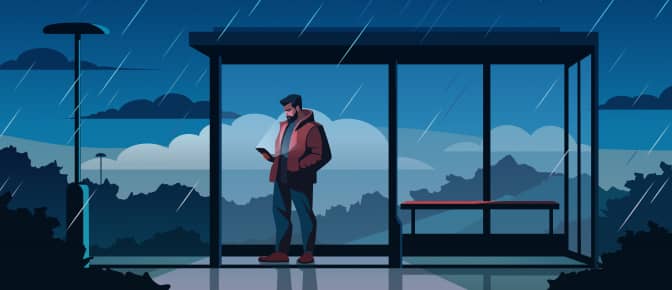Who hasn’t seen a rainbow? We observe this beautiful weather phenomenon in the rain, and it always attracts our attention. It is a common thought that a bright multicolored rainbow appears only before the end of the rain. This is not true.
A rainbow can appear even before the rain starts. You can encounter a rainbow regardless of the rain. Look, for example, at the spray of water near a fountain, illuminated by the sun, and you will notice a small rainbow in it, similar to the heavenly one. To see such a rainbow, you have to stand with your back to the sun.
Rainbow from the Historical Perspective
In the old days, when people knew very little about the world around them, the rainbow was considered a “heavenly sign”. For example, the ancient Greeks thought that the rainbow was the smile of the goddess Iris.
Attempts to scientifically explain the rainbow phenomenon were severely persecuted by the church. In the early seventeenth century, the scientist Marco Antonio de Dominis, who tried to explain the rainbow by natural causes, was excommunicated and sentenced to death. He died in prison before the execution, but his corpse was burned.
The correct scientific explanation of the rainbow appeared after people understood the nature of white light.
The Science of the Rainbow: First Explanations
About 300 years ago, the Czech scientist Jan Marek Marci discovered that white sunlight is a complex light. Marci prepared different burning glasses and observed how sunlight passed through them.

Source: Wikipedia
One day, Marci took a glass prism and placed it in the path of a thin sunlight beam in a dark room. The result was stunning: a multicolored rainbow streak appeared on the ceiling of the room. The different colors in the strip on the wall were arranged in the same order as in the sky rainbow, fading into each other. Marci realized that under certain conditions, white light decomposes into many colored rays, forming rainbow stripes.
Later, Isaac Newton continued explaining the rainbow science. He found out why a glass prism decomposes white light (processes called refraction and reflection in rainbows). It turns out that the sun’s rays, passing through the prism, deviate from their original direction (refract). At the same time, different colored rays that are part of white light are refracted differently in the prism. Red rays undergo refraction the least, and violet rays the most. Due to the different refraction, colored rays become visible when a white sunbeam passes through the prism. This phenomenon is called dispersion of light.
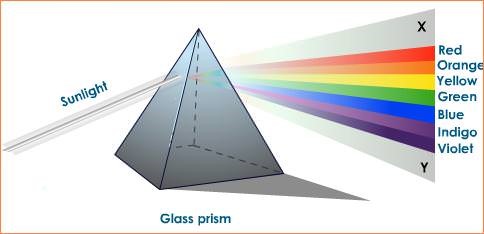
Source: tutorvista.com
The prism seems to separate the colored rays from each other. In other glasses, such as ordinary window glass, the color rays refract in the same way, and we therefore see the same white light.
The multicolored band of decomposed white light is called a rainbow spectrum. Newton said his eyes were not good at seeing the colors of the rainbow. That’s why he first split the spectrum into five colors: red, yellow, green, blue, and violet. Then he added orange and indigo, making seven colors by analogy to the number of the music notes. Scholars say that Newton’s “blue” was modern cyan, and his “indigo” was modern blue.
| Newton’s First Colors | Newton’s Later Colors | Modern Colors |
|---|---|---|
| Red | Red | Red |
| Orange | Orange | Orange |
| Yellow | Yellow | Yellow |
| Green | Green | Green |
| Blue | Blue | Cyan |
| Indigo | Indigo | Blue |
| Violet | Violet | Violet |
After the discovery of spectral colors, it became clear that in the sky rainbow, we observe the sun’s rays decomposing into a spectrum. But how does this happen in nature? What replaces the glass prism?
Rainbow Formation Explanation
Rainbows occur when the sun’s rays are refracted and reflected in raindrops. Here’s how a rainbow forms:
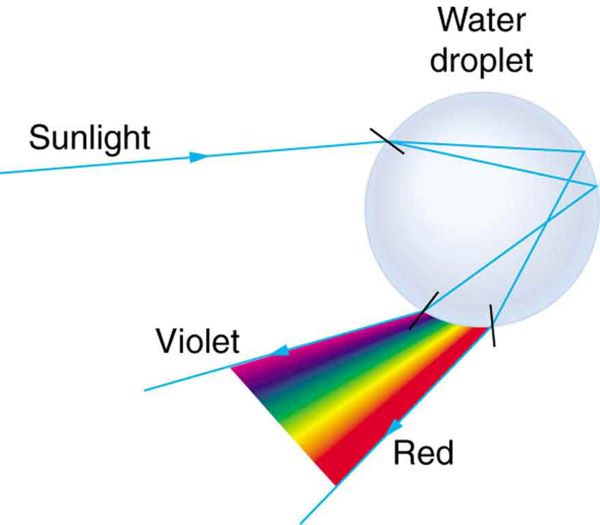
Source: BCcampus
- Rays of sunlight fall on a drop of water.
- As the light enters the raindrop, it changes its direction, refracts, and decomposes into colored rays.
- After passing through the drop, the colored rays are reflected from the opposite side of the drop and pass through the drop again.
- After leaving the drop, the colored rays are refracted again and enter the eye of the observer. In this case, as in a glass prism, the violet rays of the visible spectrum deviate most from their original direction, and the red rays deviate least. This refraction of sunlight rays occurs simultaneously in many droplets.
How to See a Rainbow
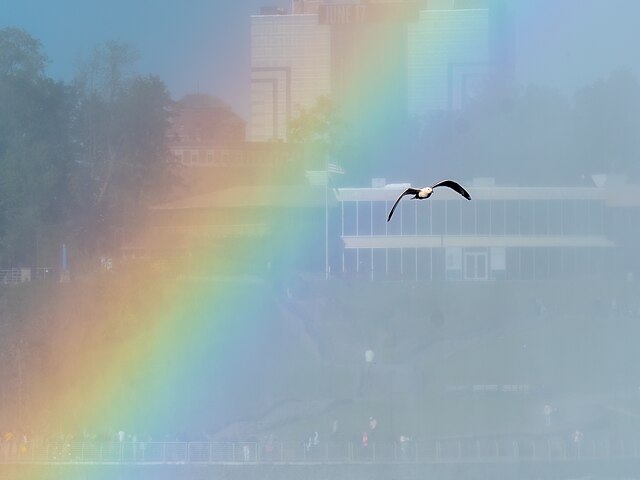
Source: Rhododendrites, CC BY-SA 4.0, via Wikimedia Commons
To see a rainbow, the observer must stand between the sun and the raindrops in which the rays are refracted, with their back to the sun. As colored rays come out of the drops at different angles, only one colored ray can reach the observer’s eye from each drop. The observer won’t see the other rays coming from the same drop: they will pass above or below the eyes.
- From the uppermost drops, the refracted rays from which the observer will still see, only red rays will reach the eye. This is because these rays are the least deflected during refraction.
- From the drops lying below, orange rays will enter the eye.
- The drops lying even lower will send yellow rays to the observer’s eyes, and so on up to and including violet rays.
- The rays reflected by neighboring drops merge, and thus the observer sees a series of colored bands, from the upper red to the lower purple.
But why do we usually see rainbows in the form of an arc? The explanation is quite simple. If you mentally connect the Sun with all the points lying, say, on the red band of the rainbow, you will get a cone-shaped surface, the axis of which passes through the eye. Each drop on this surface is in the same relation to both the Sun and the observer. Therefore, only red rays from all these drops enter the observer’s eye. Merging, they give a red arcuate line. The same line, but orange, is formed by the raindrops below, and so on. This is how a rainbow is formed, which is visible as long as the raindrops fall frequently and evenly enough.
Want to spot the next rainbow? Use Rain Viewer to track light rain showers and sun breaks - perfect conditions for rainbow formation. Stand with your back to the sun and look toward the fading rain for the best chance of catching one!
What Affects the Appearance of the Rainbow?
The best time to see a bright rainbow is after a passing shower with large raindrops, which you can track using Rain Viewer’s precipitation maps. The lower the sun, the higher the rainbow will appear in the sky.
Individual rainbow colors also look different because of the droplet size. Small droplets make purple and green brighter and blue lighter. Smaller droplets make red fade and yellow shine.
The smallest water drops that form fog and clouds do not produce rainbows. When the sun is on the horizon, we observe a rainbow in the form of a complete semicircle. As the sun rises, the rainbow size gradually decreases, sinking to the horizon. When the sun rises above the horizon above the angle of 42 degrees, the rainbow goes beyond the horizon. That is why the rainbow is not visible in summer at noon. In the afternoon, at sunset, you can see the rainbow again.
Thus, from the ground, you cannot see a rainbow of more than half a circle. But if you rise above the ground, you can see almost a full circle of the rainbow.
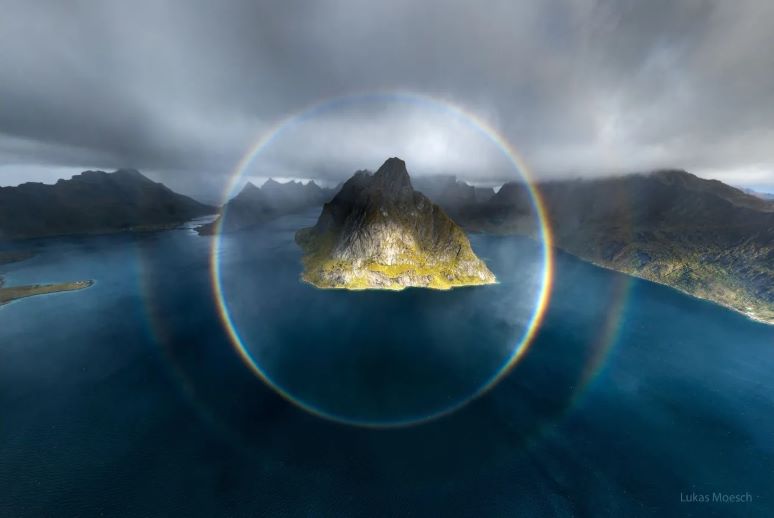
Source: Lukas Moesch
Rare Phenomena: Double Rainbows and Moonbows
Most often we see a single rainbow. However, two rainbow stripes often appear simultaneously in the sky, one above the other. In this case, the colors of the secondary rainbow are reversed from the primary rainbow. The upper part of the rainbow arc is purple, and the lower part is red.
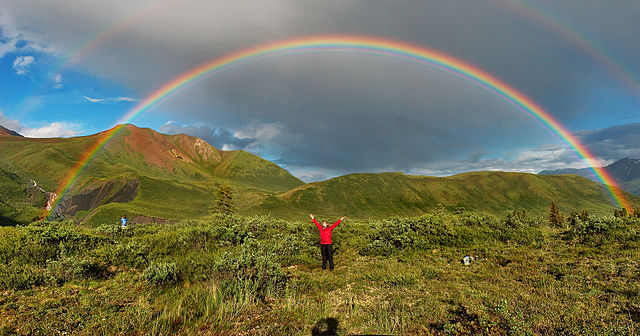
Source: Eric Rolph at English Wikipedia, CC BY-SA 2.5, via Wikimedia Commons
Double rainbows are formed when light bounces twice in water drops. Red light becomes purple light after two bounces. As more light is lost in the droplet during double reflection, the secondary rainbow always looks paler.
It is usually thought that a rainbow only happens during the day. However, it’s also possible to observe a rainbow at night, though it is always weaker and very rare. This phenomenon is called a moonbow. You can see it after a night of rain when the moon is behind the clouds. The moonbow appears in the sky in the direction opposite to the moon.

Source: Arne-kaiser, CC BY-SA 4.0, via Wikimedia Commons
Conclusion
Rainbows are a perfect mix of science and spectacle. Want to track the perfect rainbow conditions? Use Rain Viewer’s real-time rain radar to find light showers and sun breaks - then step outside and catch the magic!

